Navy Vietnam War Schererville, IN Flight date: 10/23/24
By Al Konieczka, Honor Flight Chicago Veteran Interview Volunteer
Ronald Matonovich grew up in the Hessville neighborhood in Hammond, Indiana. Ron was the oldest of five children all living in a two bedroom, one bathroom house. Ron’s father was a steel worker and tended bar on the side. Ron attended a Catholic grade school for eight years and then went to Morton High School and dropped out during his senior year. During his time in high school, he lacked the discipline he had received in elementary school. He had no interest in doing anything and seemed to have no direction in his life. He got a job working at the local A&P grocery story. When 1965 rolled around, his buddy Curt Hoggatt from down the street told Ron they better go enlist because if not they were going to be drafted. So they both tried to enlist in the Air Force and found out there was a waiting list so they decided to try the Navy. They had a deferred enlistment where they were sworn in in July but didn’t have to report to boot camp until December 28.
Ron initially started with a 3 year enlistment but the recruiter told him if he could take the GED test and pass, he would be signed up as a high school graduate and guarantee him to get into Naval school. Ron went to the Board of Education in East Chicago, IN and took the test and passed and went from a three to four year enlistment.
At just 19 years old, he was the first of his family to serve in the military. “I remember being at Great Lakes Naval base for a six week accelerated boot camp looking out this big window and thinking what did I get myself into. I had never been away from home before but I decided it was time to do something with my life. I needed to apply myself, which is something I never did in school. I liked what I was learning and started to pour myself into it. The Navy gave me the discipline and the direction I needed in my life. I graduated as honor man of my boot camp class which I was very proud of because there were guys in there who were college educated and here the high school dropout beat them all.”
After Great Lakes, Ron came home for a week and then reported on March 5, 1966, to Jacksonville, Florida, for six months of Aviation Ordinance School (AO “A”). He graduated number one in his class in AO “A” School in July and then was on to the Naval Air Station in Miramar, CA for VF-124 Training Squadron. He was assigned to the VF-53 Iron Angels Squadron near the end of September 1966.
Ron explained, “Our fighter squadron deployed to the carrier USS Hancock (CVA-19) in November of 1966. We boarded in San Diego and we went out for carrier qualifications to get acclimated to the ship. We then went on to Pearl Harbor, Hawaii and then to Yokosuka, Japan and then to Subic Bay in the Philippines and finally to the Yankee Station in the Gulf of Tonkin.”
Yankee Station was a fixed coordinate off the coast of Vietnam where U.S. Navy aircraft carriers and support ships operated in open waters during the Vietnam War. The total trip from the US to Vietnam took about 8-9 days. Ron turned 21 years old on board the ship during his first deployment to Vietnam.
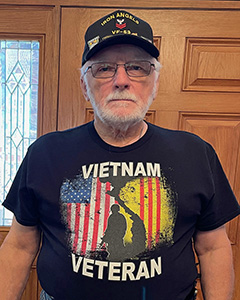
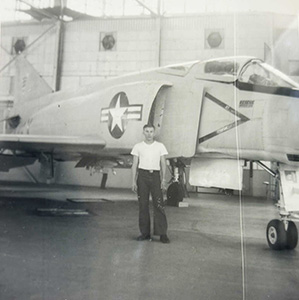
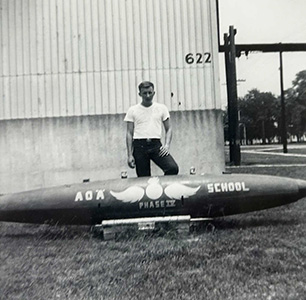
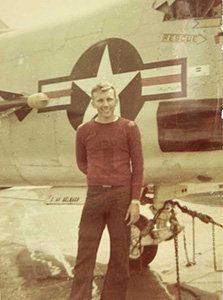
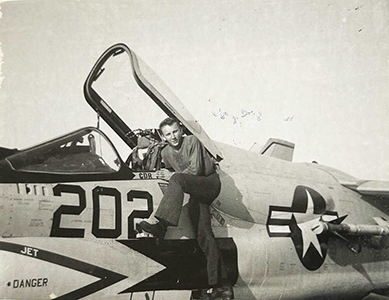
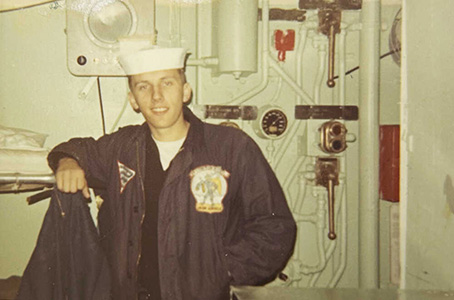
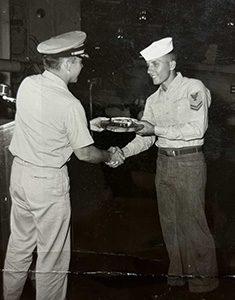
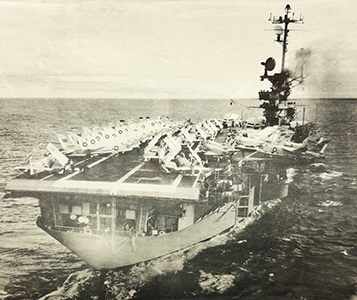
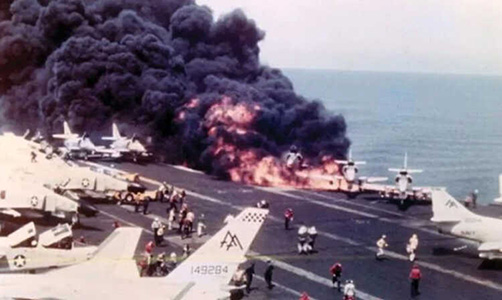
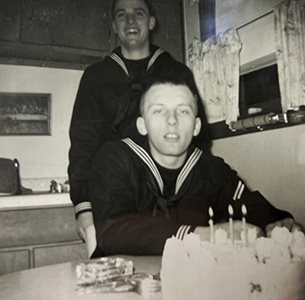

Ron explained his role aboard the ship. “The Aviation Ordnancemen were responsible for the armament systems of the planes. This included the machine guns, the bomb racks and the guided missile launchers. In AO “A” school you learned basic electronics because we had to troubleshoot the electrical systems to make sure everything was working. We had to test everything to make sure it worked properly and we loaded everything. I served as a gun crew leader, a missile crew leader, a bomb crew leader – I did everything. A typical day was like 12-16 hours.”
Ron and his crew sometimes worked in the hangar bay below deck doing repairs but most times they were on the flight deck. It’s been said that one of the most dangerous places to work is on the flight deck of an air craft carrier. “I saw this first hand. We saw people get killed every cruise we made. Some were sucked down the intake of a jet, or walked into a plane’s prop, or fell overboard and sometimes planes crashed on the deck.”
On 29 July 1967, a fire broke out on board the aircraft carrier USS Forrestal after an electrical anomaly caused a Zuni rocket on an F-4B Phantom to fire, striking an external fuel tank of an A-4 Skyhawk. The flammable jet fuel spilled across the flight deck, ignited, and triggered a chain reaction of explosions that killed 134 sailors and injured 161.
Ron recalled how their training and procedures changed after the USS Forrestal accident. “When they park planes on a carrier, they’re angled so they actually face each other. Prior to the Forrestal accident, when a plane pulled out of the pack in the back, their machine guns were ready, you just had to flip a switch in the cockpit to fire them. Bombs, missiles and rockets all had safety pins in the launchers so you couldn’t do anything until those pins were pulled. When they came up to the catapult, the cat crew would get them lined up and hooked up and then turn the plane over to me. I would signal the pilot to put his hands on his head so he’s not touching any switches. I would then signal my guys to pull the pins and signal the cat crew and they launch. After the Forrestal accident, we had to have the machine guns disconnected at the back. We had to have the umbilical cable from the missiles to the launcher disconnected. So now when it came time to launch, we had to open the door and attached two pigtails to the machine guns, one on each side and close the doors. And these doors had like 50 fasteners so it delayed each launch. And when they landed, we had to do all of that in reverse.”
The Navy was constantly making updates and modifications to the planes and procedures so upon return to San Diego they underwent additional training. “During our first cruise in ’67 the four ammo boxes had to be placed on the top of the plane. So you put one on your shoulder, then onto the missile launcher and a guy on top would grab it and set it in place. Then they started adding all these counter measures and the boxes were much larger due to all of the electronics now contained in that box. Then they started adding aluminum chaff to the planes so we had training to learn how to crawl under the planes to install that.”
Aluminum chaff is a radar countermeasure used by the military to confuse enemy radar and allow an aircraft to escape. When released from an aircraft, the chaff forms a cloud that appears as multiple targets on radar, which confuses the missile.
Ron wrote many letters back and forth to home during his time in the Navy. His wife Pam went to the same grade school, a year behind his class, and the same public high school yet they never knew each other before Ron left for Vietnam. Ron’s parents and Pam’s parents knew each other and convinced Pam to write a letter to Ron while he was serving in the Navy. In June of 1967 Ron received his first letter from Pam. “We wrote close to 900 letters back and forth to each other during my time in the Navy. We’ve kept all of them and have read them all probably close to 10 times. When I was home on leave the first time, I didn’t call her initially because I was afraid of rejection. I finally called her on August 17, 1967 and we went on our first date to the drive in theater. I saw her then every day until I went back. I told her that I loved her for the first time three days later. When I got back to San Diego I bought an engagement ring. When I returned home on leave again in December of 1967 I asked her to marry me.”
Ron was once again deployed to Vietnam, this time aboard the USS Bon Homme Richard (CVA-31). He arrived at Yankee Station at the end of February, 1968. In April, Ron was awarded the Iron Angel of the Quarter. That plaque was awarded to the enlisted man in the Fighting Fifty-Three who best demonstrated superior professional performance, devotion to duty, military bearing and leadership abilities. His ship traveled back and forth between Yankee Station and Subic Bay, P.I. between February and September, 1968. Subic Bay in the Philippines was a major base for the United States Navy during the Vietnam War. It was situated on the seaward side of the Bataan Peninsula, which separates Manila Bay from the South China Sea and was a great place for Navy and Marine Corps personnel to relax and have fun.
“We would dock in either Sasebo, Japan or Subic Bay in the Philippines. Those were our two home ports while we served out there and they were both fun. In Subic Bay they had a beach there called Dungaree Beach and we could buy a Heineken for 25 cents. The water was so clear you could walk out into the water up to your neck and look down and see your feet. In Japan, I went to a traditional restaurant way out in the country where they cooked at your table and you sat on pillows on the floor. It was a great experience and I went back there several times.”
By the start of October 1968 Ron was on his way back to the US for another leave and to get married. He and Pam had been engaged now for 10 months and they were finally married on October 26, 1968. Ron spent several months serving in San Diego before he and Pam were finally able to travel to Las Vegas for a few days together as husband and wife. Ron then headed back to San Diego for deployment one last time to Vietnam.
Ron is a devout Catholic and recalled attending mass on board the ship. “I remember going to Sunday mass in the hangar bay. They had a Catholic priest on the ship to give mass and you’re sitting there looking out over the ocean. It was quite a difference from mass at home to mass out here onboard the ship.” Ron would spend another seven months overseas before returning to San Diego, CA on October 29, 1969.
Having been separated from his new bride for nearly a year, Ron was looking for a way to possibly end his service a few months early. He read an article that if you became a law enforcement officer you could get released up to three months early from the military. Ron was finally discharged on October 29, 1969.
Ron received many several medals and awards during his Naval service including the National Defense Medal, Vietnam Service Medal (1 Silver Star, 1 Bronze Star), Vietnam Campaign Medal (W/Device), Meritorious Unit Commendation Ribbon and Navy Unit Commendation Ribbon.
After completing his service in the Navy, Ron became a policeman in Hammond, Indiana in October of 1971 and held every rank in the department all the way to chief of police. He was instrumental in computerizing the entire department. They even added the first enhanced 911 system in the state of Indiana. He left the police department in December 1996 and then did some security work for twelve years before finally retiring completely in 2008.
Ron and his wife Pam have been very happily married for nearly 56 years and have three children, five grandchildren and two great grandchildren. Ron volunteers his time these days working for a local Disabled Veterans group helping them to raise money. Ron’s 16-year-old grandson Owen has expressed an interest in working with Ron on behalf of the DAV and has even stood with him to collect money for the organization. Ron and Pam’s oldest son Christopher is a police officer in Hammond, IN following in his father’s footsteps. Ron and Pam love to spend time together building puzzles.
Ron, thank you very much for your dedicated service in the Navy and as a police officer. Enjoy your well-deserved trip to Washington D.C.!


